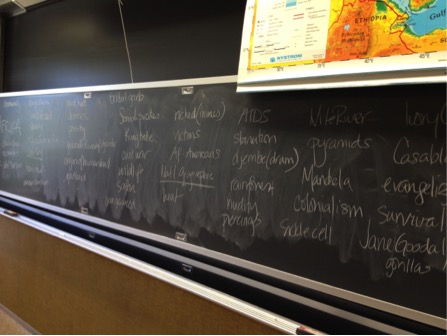Before my first-year undergraduate students begin to discuss Heart of Darkness, I ask them to think about the word Africa and make a list of all the things that come to mind. A few weeks ago, the board looked like it always does:

Photo by Colleen Lutz Clemens
Then I ask students to look for themes. They are quick to note that most of the items on the list are negative: disease, poverty and war, for instance. The positives are often animal related. (The Lion King comes up within the first 10 items every time.) But what I notice most is a theme of lack.
This activity gives us the chance to talk about the danger of thinking of Africa as a monolith, as an amorphous landmass instead of a continent made up of 54 countries. I even brought in one of my daughter’s books that has a page called “African Animals.” At home, we don’t use that title. Instead, we call the page “Animals You Might See on Safari.” I remind students that the countries that make up the African continent are entirely different places with different languages, government systems, problems, arts, literatures and more.
But it is so easy to think of Africa in a limited way when we hear only one kind of story. From Sally Struthers to Kony 2012, the most visible messages about Africa in the United States reify the idea of a monolith—and become the only story many students ever hear. My goal is to help students see that other stories come along with those stories, that the continent has strife but also has poets, novelists, doctors, university professors, activists and other kinds of thinkers. By reading texts created by these thinkers, students can start to complicate their idea of Africa.
Finding stories that show the complexity of life on the continent takes some time and effort due to the overwhelming media focus on tragedy there. However, as scholars and teachers, we are obligated to do this work. This consideration includes our use of Chinua Achebe’s novel Things Fall Apart (1958) as the primary voice of African literature in the classroom. A monolith of its own now, the novel and its main character, Okonkwo, speak only for a specific clan in a specific ethnic group—Igbo—in a specific nation—Nigeria. When we teach this novel as “The African Novel,” we reify the notion that the African continent has one essential story, a story that Chimamanda Ngozi Adichie reminds us is limiting in her TED Talk, “The Danger of a Single Story.” And if we do not teach any other works by writers from Africa or the African diaspora, we convey to students that there is only one storyteller and thereby silence an entire continent.
For teachers who have administrative support to consider and adopt new texts, I would like to offer some suggestions that can help students consider experiences beyond Okonkwo’s. These readings can help them see that there are many voices writing from multiple perspectives—perspectives that may mirror their own. These titles share themes attractive to young adult readers, including coming of age in the midst of personal struggles, conflict and social change.
Chimamanda Ngozi Adichie, Purple Hibiscus (2003). This novel takes the reader inside the Achike household, a well-off Nigerian Catholic family terrorized by the father, Eugene. Narrated from the perspective of the 15-year-old daughter, Kambili, the story follows the destruction of the family at the hands of Eugene. Her moments of self-discovery and freedom are disrupted when domestic violence leads to a family tragedy.
Buchi Emecheta, The Bride Price (1976). This bildungsroman tells the story of Akunna as she transitions into adulthood in Nigeria. Upon her menarche, she is considered marriageable, but her desire to marry for love makes her hide her period. A tale of growing up, falling in love and leaving the family home, this novel gives students an opportunity to connect with and feel empathy for this young protagonist.
Athol Fugard, “Master Harold”…and the Boys (1982). Fugard’s play shows Hally’s maturation as a young white boy in apartheid South Africa. With only three characters, this play is an easy read while it teaches challenging concepts of race. Hally’s love for Sam and Willie is in crisis when he realizes that in order to survive as a white man in a racially divided country, he must denounce those he loves to fulfill the role expected of him. All three of the characters have lost something by the end of this heartbreaking play.
Marguerite Abouet, The Aya Series (Series begins in 2007). Illustrated by Clément Oubrerie and translated by Helge Dascher, this series of graphic novels centers on Aya, a young woman in the Ivory Coast in the late 1970s. Aya is a vibrant, career-minded teenager coming of age during a time of political unrest.
Kopano Matlwa, Coconut (2008). Told in two voices, this novel explores the challenges of racial identity in South Africa. Ofilwe and Fikile are both coming to terms with being “coconuts,” a derogatory term meaning they are black on the outside but white on the inside. As each character comes of age, she struggles with her identity in ways that students will be able to connect with, even if they live thousands of miles away from the novel’s setting.
Robin Malan, The Story of Lucky Simelane (2006). This short novel shares themes and setting with Coconut while focusing on a male experience. Lucky has “white features” that set him apart from his community. The novel focuses on his search for a personal identity in a South Africa still recovering from apartheid and its forcing of racial identities on its entire population.
Clearly, any list will fall short of helping students understand the diversity of the African continent. You can seek out texts beyond these titles and evaluate them for their contribution to your students’ diverse reading experiences using this tool.
Clemens is the associate professor of non-Western literatures at Kutztown University in Pennsylvania.

0 COMMENTS